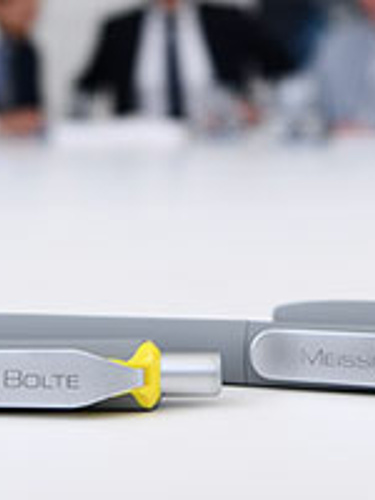



A. Introduction
Trademarks are used to distinguish the goods and services of a company from those of other companies (see Sec. 3 (1) Trademarks Act; Article. 4 European Union Trademark Regulation, EUTMR). A wide variety of different signs can be registered or protected as trademarks. Today, it is even possible to register or protect videos or sounds as trademarks.
It is, therefore, most desirable to protect the form of a product itself by means of a trademark. This seems all the more justified,
since the appearance of a product is one of the main distinguishing features from the products of other companies.It is, therefore, not surprising that the Trademarks Act also explicitly mentions the three-dimensional shape of a product or its packaging as a possible sign for a trademark (Sec.3 (1) Trademarks Act; Article 7 (1) e EUTMR). A trademark which shows the product to be protected by the trademark itself is also referred to as a “shape mark”.
It therefore seems obvious to protect the visible and even technical characteristics of a product by means of a commodity shape mark. This has the advantage of a possible indefinite term and, due to the absence of a novelty requirement in trademark law, can still be obtained and maintained after the expiration of a patent or design.
B. Distinction between trademark protectionand other industrial property rights
Shape marks are, however, subject to special requirements which make it more difficult to register shape marks than other more traditional marks.
The Trademark Act and the European Union Trademark Regulation provide for a number of distinctions from other types of intellectual property rights, such as designs or patents. The legislator’s aim is to prevent a temporally unlimited monopolisation of technical or aesthetic features. This is to ensure that the time-limited protection afforded by a patent or design cannot be bypassed with indefinite protection by means of a shape mark.
For this purpose, Sec. 3 (2) Trademark Act contains provisions which implement the above objective (corresponding to Article 7 (1) e EUTMR for European Union Trademarks).
Therefore, signs consisting exclusively of a shape are not eligible for protection as trademarks,
1. when this shape results from the nature of the goods themselves;
2. when this shape is necessary to obtain a technical result; or
3. when this gives substantial value to the goods.
The abovementioned grounds for refusal are of particular importance, since they cannot be overcome by heavy market penetration of the trademark and lead to an automatic refusal of the trademark registration.
Until a few years ago, the aforementioned obstacles enjoyed a rather niche existence which was due to a very Applicant-friendly interpretation by the Federal Court of Justice. It was therefore quite possible to protect technical solutions with a trademark for an unlimited period of time.
C. The ECJ sets the rules
In the decision Hauck vs Stokke (C-205/13) from 2014 regarding the well-known ‘Tripp Trapp’-chair, the European Court of Justice (ECJ) dealt intensively with the interpretation of the impediments under Sec. 3 (2) Trademarks Act and Art. 7 (1) e EUTMR, which are each based on the European Trademark Directive. In the abovementioned decision, the ECJ stated with regard to the grounds for refusal under Sec. 3 (2) No. 1 Trademarks Act that: it is sufficient for fulfilling the grounds for refusal if the shape mark consists of one or more essential characteristics which are inherent to the generic function or functions of that product and which consumers may be looking for in the products of competitors.
With respect to the ground for refusal in accordance with Sec. 3 (2) No. 3 Trademarks Act, the ECJ stated that the ground for refusal of registration is applicable to signs which consist exclusively of the shape of a product having several characteristics which may, in different ways, each confer on it a substantial value.
The ECJ further states that the essential characteristics of a sign, i.e. its most important characteristics, are first determined by determining the overall impression or by examining the components of the sign. It must then be examined whether all of the essential characteristics taken together fall under one of the grounds for refusal Sec. 3 (2) No. 1 Trademarks Act would not apply if a further element, such as a decorative or imaginative element not inherent in the function typical of the generic category, is of significance or essential to the shape of the goods.
The decision of the European Court of Justice thus conflicts with previous German case law. From this decision onward it is necessary, for example, that at least one feature has no technical function at all.
The Federal Court of Justice has now had the opportunity to incorporate the opinion of the European Court of Justice into its decision-making practice. The Federal Court of Justice had to decide on two cases: in the first, a product shape mark for ‘Rittersport’ chocolate or its packaging was involved (Federal Court of Justice, decision of 18.10.2017 - I ZB 105/16); in the second, dextrose platelets from the company Dextrose Energy were involved.
In the first case, the Federal Patent Court had, in the first instance, ordered the cancellation of the mark, since it considered that all the characteristics of the mark were due to the shape of the product itself, so that there was a ground for exclusion under Sec. 3 (2) No.1 Trademarks Act. This was objected to by a further decision of the Federal Court of Justice.
In particular, the FCJ did not follow the Federal Patent Court when stating that the square shape of the packaging is determined exclusively by the nature of the product.
The design of the dextrose platelets from the company Dextrose Energy was cancelled by the Federal Patent Court with reference to Sec. 3 (2) No. 2 Trademarks Act. In its decision, the FCJ states that a cuboid shape and a predetermined breaking point are exclusively technical features. However, chamfered edges which lead to an improved sensory effect when consumed are not to be regarded as technical, so that the mark does not need to be cancelled.
D. Conculsion – Notes for use in practice
In principle, the protection of shape marks has become more difficult since the ECJ ruling in 2014. That said, the FCJ apparently tries to interpret the principles of the ECJ broadly, so that the registration of shape marks continues to be possible in some cases. The Federal Patents Court continues to apply a seemingly strict standard, meaning that a shape mark for Nespresso capsules has also been deleted by the Federal Patents Court (25 W (pat) 112/14).
Moving forward, it is clear that the registration of a shape mark must be carefully considered and planned. Before registration of a shape mark, those features of a shape should be identified which relate to the shape of the goods, may be considered to have a technical function or to significantly influence the value of the goods. For each of these groups of features, at least one feature of the mark which does not fall under the exclusion should be identified prior to registration of the shape mark. If at least one feature is identified in each category, a registration may be more likely to succeed.
In addition, it is still essential for shape marks that they differ significantly from the familiar shapes on the market, otherwise the necessary distinctiveness under Section 8 (2) No 1 Trademarks Act will lead to rejection: the lack of distinctiveness can only be compensated by a very high degree of recognition in the relevant market.
Should you wish to protect a product as a shape mark, we will be pleased to support you as part of a personal consultation or by means of one of our in-house seminars. Please do not hesitate to contact us.